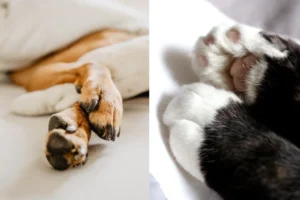Cats are fascinating creatures with unique characteristics that often leave us wondering about the reasons behind their behaviors. One such feature that has puzzled cat owners is the presence of dewclaws on their paws. Have you ever wondered why cats have dewclaws? Let’s explore the reasons behind this seemingly mysterious trait.
Evolutionary Purpose
Dewclaws, those tiny claws on the inner side of your cat’s paws, actually serve a bigger purpose than you might think. These little quirks of nature have evolutionary roots that trace back to our feline friends’ ancestors. Back in the day, when cats roamed the wild, dewclaws played a vital role in hunting and survival. They provided extra traction and stability during high-speed pursuits, allowing cats to outmaneuver their prey with precision and agility.
Additionally, dewclaws helped ancient cats climb and navigate rough terrain more efficiently, giving them an edge in their daily struggle for survival. While modern house cats may not rely on these skills as much, the vestigial dewclaws remain as a nod to their wild past. So next time you look at your cat’s dewclaws, remember that they are a tiny connection to a long line of skilled hunters and agile climbers.
Functional Benefits
Have you ever noticed your cat using its dewclaws to grip onto toys, furniture, or even your leg during playtime? That’s because these seemingly insignificant claws actually serve a handful of functional benefits for your feline friend. Beyond their evolutionary origins, dewclaws come in handy in everyday activities like climbing, grooming, and hunting (if your cat is feeling particularly adventurous).
Dewclaws provide extra gripping power, allowing cats to navigate tricky surfaces with ease. They also assist in grooming, as cats use them to clean hard-to-reach spots on their bodies. Additionally, these claws can help cats defend themselves in a pinch, adding an extra layer of protection in confrontational situations.
So, the next time you see your cat flexing its dewclaws, remember that they’re not just for show. They’re a practical tool that adds an extra layer of versatility to your feline companion’s impressive skill set.
Differences in Dewclaws
Dewclaws in cats can vary significantly across different breeds. While some cats may have well-developed dewclaws that resemble a functioning thumb, others may have barely noticeable ones that seem more like vestigial remnants. These variations are largely influenced by genetics and the environment in which the cats evolved. For instance, breeds that are more prone to climbing or digging may have more prominent dewclaws that help them with these activities. On the contrary, breeds that primarily stay indoors may have dewclaws that are less functional. Understanding these differences can provide insight into how cats’ dewclaws serve different purposes based on their genetic makeup and lifestyle.
Behavioral Significance
Cats can use their dewclaws for various behavioral purposes that go beyond just an anatomical feature. These unique claws can serve as a form of communication, as cats may use them to mark their territory by scratching surfaces. Dewclaws can also play a role in self-defense, giving cats an additional tool to protect themselves when feeling threatened. Additionally, some cats may use their dewclaws in grooming, as they can help in holding onto objects while cleaning themselves. By observing how cats interact with their dewclaws, we can gain valuable insights into their behavioral patterns and understand the significance of these seemingly small appendages.
Additional Insight:
One interesting aspect of dewclaws is that they can sometimes have a dual function in cats. While they may primarily serve as an aid in gripping or scratching, some cats have been observed using their dewclaws in a more delicate manner, such as when playing with objects or even manipulating food. This versatile use of dewclaws showcases the adaptability and resourcefulness of cats in creatively utilizing all parts of their anatomy for various tasks.
Dewclaw Trivia
Let’s dive into some interesting facts about dewclaws on cats that you might not know. Did you know that dewclaws are essentially the equivalent of our thumbs? They help cats grip onto prey and climb with ease. In addition, some cats’ dewclaws are even equipped with small muscles, allowing for more flexibility and dexterity. It’s fascinating how these seemingly small claws play such a crucial role in a cat’s daily activities.
Dewclaw Removal
When it comes to dewclaw removal in cats, it’s essential to consider the ethical implications and potential impacts on their well-being. While some argue that removing dewclaws can prevent injuries or reduce scratching damage, others believe it’s an unnecessary procedure that can cause pain and distress to the cat. Before opting for dewclaw removal, it’s crucial to consult with a veterinarian to weigh the pros and cons carefully. Remember, cats rely on their dewclaws for various purposes, so it’s vital to consider the long-term effects of this decision.
Additional Insight:
Did you know that some cat breeds, such as the Maine Coon and Abyssinian, have been known to have multiple dewclaws on their front paws? This adaptation can provide them with even more agility and gripping power, showcasing the diversity of these unique feline claws.
Tips for Dewclaw Care
Caring for your cat’s dewclaws is essential to keep them healthy and functional. Make sure to regularly check the dewclaws for any signs of injury or infection. Keep them trimmed to prevent overgrowth and potential snagging on objects. If your cat’s dewclaws are excessively long, consider having them trimmed by a professional groomer or veterinarian.
Additionally, provide your cat with scratching posts to help them naturally wear down their claws, including the dewclaws. This will prevent the dewclaws from becoming overgrown and causing discomfort to your furry friend. Remember to reward your cat with treats and praise when they use the scratching post to encourage good behavior.
Lastly, keep an eye on your cat’s dewclaws during regular grooming sessions. If you notice any redness, swelling, or discharge around the dewclaw area, consult your veterinarian immediately to address any potential health issues before they escalate.
Conclusion: Dewclaws in Cats
In conclusion, dewclaws are a unique feature in feline anatomy that serve as a source of stability and balance for cats. These seemingly vestigial claws play a crucial role in climbing, hunting, and grooming. Understanding the purpose of dewclaws can help cat owners appreciate their significance in a cat’s daily life.
By providing proper care and attention to your cat’s dewclaws, you can ensure they remain healthy and functional, ultimately contributing to your cat’s overall well-being and quality of life. Remember to monitor your cat’s dewclaws regularly, trim them as needed, and seek veterinary advice if any issues arise. Your furry friend will thank you for keeping their dewclaws in top condition!
Alex, a passionate animal lover, has experience in training and understanding animal behavior. As a proud pet parent to two dogs and three cats, he founded AnimalReport.net to share insights from animal experts and expand his knowledge of the animal kingdom.




